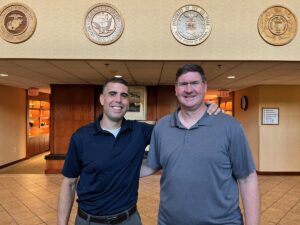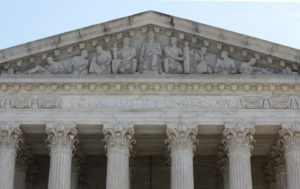
SAN DIEGO, Calif. (BP)–Stanford Linzey was aboard the USS Yorktown when it sustained a trio of bombs and two torpedo blasts nearly six months after the Japanese bombed Pearl Harbor.
Not only did he survive World War II, the former Naval chaplain wrote a book about it. Published by a small company in California, “God Was at Midway” is stocked by the bookstore at the U.S. Naval Academy. On Memorial Day, Linzey did a book signing aboard the USS Arizona.
Though still fond of the military branch he served as a chaplain, Linzey believes his son, George, is justified in suing the service for alleged religious discrimination.
“He has one of the finest records in the Navy and then is separated,” said Stan Linzey, of Escondido, Calif. “I can’t blame him, and many others, for being upset. If they can’t hack it, that would be one thing. But if they’re separated for no reason, that’s something else.”
The younger Linzey is part of a class action lawsuit that includes five current or former Southern Baptist chaplains.
It is one of five lawsuits filed against the Navy since October 1999. One was dismissed, but that ruling has been appealed in federal court.
Stan Linzey, who was endorsed by the Assemblies of God, said discrimination existed back in the 1940s.
In one of his assignments in Okinawa, everyone up the chain of command was Catholic. That left an evangelical with no one from a similar background to appeal to if he encountered difficulties, he said.
Stan Linzey said the Navy has long been flagrant in its favoritism of Catholics and mainline liturgicals. Not only are they routinely promoted, but few faced any disciplinary problems compared to evangelicals, he said.
Despite this treatment, Stan Linzey said he didn’t get too concerned about discrimination because he assumed the Lord would take care of him.
“I just did my job,” he said. “I had the largest program in the Navy and they knew it. But in this day and time they can’t get away with it like they could in my time.”
His son, George, is the only Pentecostal to serve as senior Protestant chaplain of the Naval Academy. At age 41, he also became the youngest chaplain to make captain.
In the class action suit, he accused the Navy of selecting him for early retirement in 1998 for religious reasons instead of his chaplaincy record.
Although many consider 20 years a career — and he served for 21 — George Linzey said many chaplains stay up to 26 years to earn better retirement pay.
Endorsed by the Pentecostal Church of God, based in Joplin, Mo., the former chaplain said his forced retirement reduced the number of chaplains from his small denomination to one.
“When the Navy cut down from 110 to 84 captains in the Chaplain Corps from 1992 to ’98, you can imagine who got to go home,” he said. “Over half were non-liturgical. The year I was asked to [leave], not a single high-church Protestant was asked to go home.”
George Linzey said his departure was painful since he had sensed the Lord’s call to ministry at the age of 5. He loved to watch his father work and prayed, “God, if you make me a chaplain and an organist, I will serve you for the rest of my life.”
“I never took my eyes off that,” said Linzey, whose organ-playing ability has helped him cross many denominational barriers. “I knew that God could answer my prayer.”
Ironically, as a young teenager he said his father warned him to remember that there were three different Chaplain Corps — Catholic, liturgical Protestants and “the rest of us.”
Everything his father said proved to be true, George commented. Chaplains who were disciplined for problems were always from non-liturgical groups, he said.
At annual meetings, priests and rabbis used to comment how sorry they felt for evangelicals because of the treatment they suffered, he said.
However, George Linzey — and other plaintiffs in the class action suit — claim such discrimination is rooted in a tradition more than 150 years old. To support that contention, Linzey points to an official Naval document that traces the history of the Chaplain Corps from 1778 to 1939.
The book documents complaints that surfaced in the early 1840s regarding the chaplain’s uniform. In January 1844 the Navy Department issued a regulation saying a chaplain could wear a black gown, plain black coat or uniform coat.
The relevance of that regulation is it touches on a complaint non-liturgicals had about the use of gowns and the Episcopal prayer book as part of services. Others said the Navy had appointed a disproportionately large number of Episcopal chaplains.
Ultimately the matter ended up in the House of Representatives, which in 1859 requested an explanation, according to the book.
The secretary of the Navy submitted a list of 61 chaplains appointed from 1815 to 1856 and reported only 10 were Episcopalians. However, 33 were listed as “unknown.” A later classification showed that 24 of the 61, or 40 percent, came from Episcopal backgrounds.
Chaplains also were disturbed about being handicapped in their duties by their commanding officers. One wrote to the secretary of the Navy in 1853:
“My experience of nearly twelve years in the service is, that the Chaplain [who] gets on the most smoothly with his superiors does the least for Christ & his cause. Hence it is that chaplains who have entered the service in hope of doing good soon find their zeal quenched.
“And … their personal piety is subject to the most unfavorable social influences. Besides these considerations, there is no ecclesiastical power to which chaplains are accountable. Are they not on the whole about as faithful as we can expect them to be under the existing system?”
The same difficulties still exist, George Linzey said.
“The general rule is the non-liturgicals have to work harder than anyone else because it’s harder for them all the way to the top,” he said. “The non-liturgicals pose the biggest threat because they help the sailor to open his eyes spiritually.”
–30–
(BP) photo posted in the BP Photo Library at https://www.bpnews.net. Photo title: STANFORD E. LINZEY.















